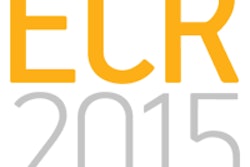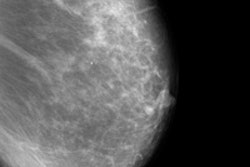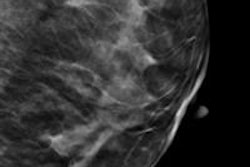
Synthetically reconstructed 2D images with digital breast tomosynthesis (DBT) was comparable to conventional 2D mammography with DBT for breast cancer screening, in a Norwegian study presented at this month's RSNA meeting in Chicago.
Taking full-field digital mammography (FFDM) images as well as tomosynthesis images doubles a woman's radiation dose, so using synthetic 2D images with tomosynthesis would be better for patients, the researchers noted.
Dr. Per Skaane, PhD, from the University of Oslo, and colleagues compared the diagnostic performance of full-field digital mammography (FFDM) plus DBT with that of synthesized 2D images plus DBT for breast cancer screening. The study is part of the Oslo Tomosynthesis Screening Trial, which began in 2010 and receives equipment and support from Hologic.
Skaane's team used Hologic's C-View 2D imaging software and Selenia Dimensions 3D breast tomosynthesis system for their research. The software is designed to enable tomosynthesis to produce 2D mammography images without the higher radiation dose typically involved in combined 2D/3D studies.
Are 2D images really necessary? Yes, Skaane told session attendees: Having 2D mammography images in addition to the tomosynthesis images is important for many reasons, including the ability to compare priors to current exams, compare the right versus left breast, and provide current 2D exams to other institutions.
Furthermore, studies have shown that the combination of 2D and DBT has a higher cancer detection rate and a lower recall rate, he said.
For the study, eight radiologists interpreted 12,271 screening examinations including FFDM plus DBT and synthesized 2D plus DBT using a five-point rating scale to measure probability of cancer. Both reading modes included standard craniocaudal (CC) and mediolateral-oblique (MLO) views of each breast; all cases with a score of 2 or higher were discussed to reach consensus on whether a woman should be recalled. Skaane and colleagues assessed the two combinations for positive predictive value, recall rate, and cancer detection rate.
The interpreting radiologists found 656 (5.3%) cancers from the FFDM plus DBT combination, compared with 651 (5.3%) from the C-View plus DBT combination. After the arbitration meeting, there were 297 recalls (2.4%) for FFDM plus DBT and 270 (2.2%) for C-View plus DBT. The cancer detection rate was the same for each combination, at 0.81% (100 of 12,271), the researchers found.
Overall rates of cancer detection for the interpreting radiologists were 87.3% with FFDM plus DBT and 85.5% with C-View and DBT, Skaane said.
"Synthesized 2D plus DBT is acceptable for routine use in mammography screening, and may replace FFDM in clinical practice," he concluded.



















